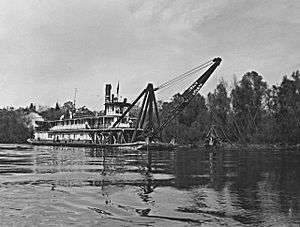Snagboat


A snagboat is a river boat, resembling a barge with superstructure for crew accommodations, and deck-mounted cranes and hoists for removing snags and other obstructions from rivers and other shallow waterways.
During the American Civil War, when much of the naval fighting was done on rivers and their tributaries, numerous snagboats were in operation. USS Benton, for example, was a commercial snagboat quickly converted by the Union Army to a river gunboat when the American Civil War broke out.
In Canada, many of the rivers of British Columbia were maintained and kept open for navigation by federal Department of Public Works snagboats. On the Fraser River, in southern British Columbia, a series of sternwheeler snagboats named Samson were operated by the Canadian Federal Government from the early 1880s until the retirement of final vessel in the series, the Samson V in 1980. The Samson V is now preserved as a museum on the waterfront of New Westminster, B.C. and was the last steam -powered sternwheeler to operate in Canada. In northern British Columbia, Department of Public Works snagboats operated out of Prince Rupert and cleared the waters of the Nass, Ecstall, and Skeena rivers.
The snag-clearance service was mainly important on the Fraser River because of the large amount of marine traffic. Passenger and freight-carrying sternwheelers operated out of New Westminster from 1859 until the early 1920s. These lightly built vessels were vulnerable to the woody debris and drift logs that would wash down the river with every spring freshet. After the 1920s, most of the traffic on the Fraser was tug and barge service along with deep sea shipping in the lower reaches of the river, and a greater portion of the snagboat's assignments was in maintenance of government docks and aids to navigation. In northern British Columbia, as on the Fraser River, a major part of the snagboat service provided by the Canadian federal government was in support of the gillnet salmon-fishing industry and the canneries that were built in and around the estuaries of the major rivers. Huge amounts of timber debris would wash down-river every year creating hazards for fishermen and destroying nets.
See also
References
- Sheret, Robin E, "Smoke, Ash and Steam: West Coast Steam Engines". Western Isles, Victoria, B.C. 1997,
- Stroh, Scott. "The Snagboat W. T. Preston: A Case Study in the Dry Berth Preservation of Historic Vessels". San Francisco Maritime National Historical Park Association.
- "Snagboat E. A. Woodruff". Ohio County Public Library. Archived from the original on June 5, 2011.
- "U.S. Snagboat Montgomery Pickensville, Alabama". The History Workshop. Archived from the original on 2008-07-23.
- Martin, Mark E., ed. (2006). "Army Corp of Engineers river snagboat C. R. Suter photographs, ca. 1885" (pdf). Louisiana State University Libraries (Archive inventory). Louisiana State University.